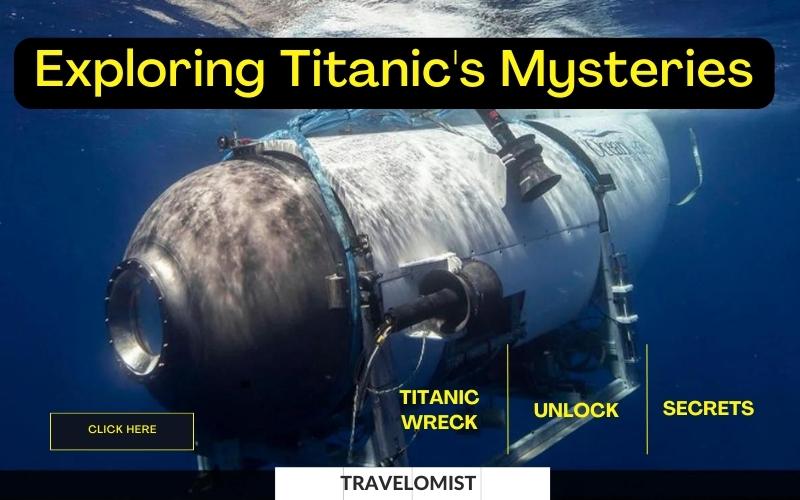The term “Titanic submersible” refers to a type of underwater vehicle or submersible that is specifically designed and used for exploring the wreck of the RMS Titanic. These submersibles are advanced deep-sea exploration vessels that are capable of descending to great depths and maneuvering through the underwater environment to reach the Titanic’s resting place.
Titanic submersibles are equipped with robust structural integrity to withstand the extreme pressures of the deep-sea environment. They often feature powerful lights to illuminate the darkness of the ocean depths, as well as advanced imaging systems to capture high-resolution images and videos of the wreck.
These submersibles may also include robotic arms or sampling equipment, which allow researchers and explorers to collect artifacts or conduct scientific investigations during their explorations of the Titanic.
The use of Titanic submersibles has played a crucial role in documenting the condition of the wreckage, studying the impact of the deep-sea environment, and uncovering new insights into the historical significance of the Titanic disaster.
It’s important to note that there have been several different submersibles used in expeditions to explore the Titanic wreck, each with its own specific design and capabilities. Examples of such submersibles include Alvin, Mir, The Titan and Nautile, among others.
In this blog post, we embark on an extraordinary journey as we delve into the depths of history with the Titanic submersible, exploring the ship’s hauntingly beautiful final resting place.
As we descend into the abyss, surrounded by the echoes of a bygone era, we bear witness to the solemn remnants of a once-great vessel, forever etched into the annals of history. The Titanic submersible takes us on a remarkable voyage, where the past and present converge in a mesmerizing exploration of one of humanity’s most enduring tales. Step aboard, and let us embark on this unparalleled adventure to unlock the secrets of the Titanic’s final resting place.
The Titanic’s Sinking And Its Resting Place
The world was forever changed on the fateful night of April 14, 1912, when the RMS Titanic, the majestic British passenger liner, met its tragic fate in the icy depths of the North Atlantic Ocean. Over a century later, the Titanic’s final resting place continues to captivate the imagination of explorers and history enthusiasts alike.
The RMS Titanic, touted as the “unsinkable” ship, set sail on its maiden voyage from Southampton, England, to New York City, USA. However, tragedy struck on the night of April 14, 1912, when the Titanic collided with an iceberg in the frigid waters of the North Atlantic. Despite efforts to save the ship, it succumbed to the relentless forces of the ocean, sinking in the early hours of April 15.
The exact location of the Titanic’s resting place remained a mystery for several decades. It wasn’t until September 1, 1985, when a joint American-French expedition, led by Dr. Robert Ballard, discovered the wreckage lying at a depth of approximately 3,800 meters (12,500 feet). The ship’s final resting place was identified about 600 kilometers (370 miles) southeast of Newfoundland, Canada.
The Titanic wreckage now lies on the seabed, shrouded in darkness and silence, marking the spot where a tragedy of immense proportions unfolded. The site is considered a maritime memorial, a poignant reminder of the lives lost and a testament to the human fascination with the unsolved mysteries that lie beneath the waves.
The Concept Of Using Submersibles For Exploring The Wreck
Exploring the depths of the ocean is a formidable task, and traditional diving methods cannot reach the extreme depths where the wreck of the Titanic lies. This is where submersibles come into play, revolutionizing our ability to reach and study the Titanic’s resting place.
Submersibles are specially designed vehicles that can withstand the immense pressure and hostile environment of the deep sea. These sophisticated vessels are built to venture into the abyss, carrying researchers and adventurers to the depths where the Titanic resides.
Equipped with advanced technology, submersibles provide a means to explore the Titanic’s wreckage with precision and detail. Powerful lights illuminate the dark depths, allowing researchers to capture high-resolution images and videos of the ship’s remains. They also feature robotic arms and sampling equipment, enabling the retrieval of artifacts and conducting scientific investigations.
Submersibles not only allow us to physically reach the Titanic but also offer a unique perspective on the wreck and its surroundings. They provide a captivating and immersive experience, enabling researchers and visitors to witness the haunting beauty of the Titanic’s final resting place firsthand.
Through the use of submersibles, we have been able to unravel the mysteries of the Titanic, gaining insights into its structural integrity, the impact of the ocean’s forces, and the stories held within its wreckage. These remarkable vessels have opened a window into the past, deepening our understanding of this iconic tragedy and the human stories it represents.
The Submersible Expedition
Using advanced technology and deep-sea exploration vehicles, a team of intrepid adventurers set out on a mission to reach the Titanic’s resting place. Equipped with state-of-the-art submersibles, purpose-built to withstand the immense pressures of the ocean depths, they descended into the abyss, venturing closer to the haunting remnants of the iconic vessel.
With careful planning and meticulous preparation, the submersible expedition embarked on a journey that few have ever experienced. As they descended through the water column, the world above faded away, replaced by an otherworldly environment teeming with mysteries waiting to be unveiled.
The submersibles, designed with robust construction and advanced navigation systems, allowed the explorers to navigate the treacherous terrain surrounding the Titanic’s wreckage. Inch by inch, they carefully maneuvered through the dark and silent depths, their excitement mingled with a profound sense of reverence for the historical significance of their surroundings.
Descending deeper into the ocean, the submersibles reached the final resting place of the Titanic. A hushed awe fell over the expedition team as the haunting silhouette of the ship’s remnants emerged from the gloom. The submersible’s powerful lights illuminated the scene, revealing the majestic yet eerie remains of the once-great vessel.
As the submersibles glided past the hull, they captured breathtaking images and videos, documenting the intricate details of the wreckage. The preserved artifacts, frozen in time, whispered stories of the passengers and crew who embarked on that ill-fated voyage.
The submersible expedition went beyond mere observation; it was a quest for understanding. Scientists and researchers onboard meticulously collected data, conducting studies to uncover the secrets held within the Titanic’s ruins. They studied the effects of corrosion, the patterns of debris, and the ecological impact of the wreck on the surrounding marine life.
With each dive, the submersibles ventured deeper into the heart of the Titanic’s tragedy. They explored the grand ballrooms and luxurious cabins, now submerged in darkness. They traced the contours of the ship’s structure, seeking answers to the questions that have lingered for over a century.
Through the submersible expedition, a deeper connection was forged with the Titanic and its legacy. The explorers, touched by the magnitude of the disaster and the personal stories entwined within the wreckage, became ambassadors of remembrance and preservation. They recognized the significance of their role in protecting and honoring the memory of those who lost their lives on that fateful night.
As the submersibles ascended back to the surface, the expedition team carried with them a profound sense of awe and responsibility. The Titanic submersible expedition not only shed light on the tragedy but also sparked a renewed commitment to preserving the fragile remains for future generations.
The Wreck’s Condition And The Impact Of The Deep-Sea Environment
As the submersible expedition reached the depths of the Titanic’s resting place, they were met with a scene of both haunting beauty and tragic decay. The once majestic ship, which proudly sailed the seas, now lay in a state of profound deterioration.
The hull of the Titanic, once a marvel of engineering, has been ravaged by the relentless forces of the deep-sea environment. Corrosion and decay have taken their toll on the structure, leaving twisted metal and fragmented sections in their wake. The submersibles’ lights cast an eerie glow on the wreckage, accentuating the stark contrast between the grandeur it once possessed and the somber reality of its current state.
The impact of the deep-sea environment on the Titanic’s remains cannot be understated. The extreme pressure at these depths, combined with the cold temperatures and lack of light, create a hostile environment that accelerates the natural deterioration process. Rusticles, icicle-like formations of rust, hang from the ship’s surfaces, evidence of ongoing corrosion.
The deep-sea environment also plays a role in the colonization of the wreckage by marine life. As the submersibles maneuvered through the debris, they encountered an ecosystem that has made the Titanic its home. The wreck has become an artificial reef, providing a substrate for various organisms to thrive. From vibrant coral growth to the presence of deep-sea creatures, the wreck has become a sanctuary for marine life.
While the deep-sea environment has been both a destructive and transformative force for the Titanic, it has also acted as a preserver of history. The cold temperatures and absence of oxygen at these depths have helped to slow the natural decay process and protect certain elements of the ship. Personal belongings, furniture, and artifacts lie scattered throughout the wreckage, offering glimpses into the lives of those who sailed on the ill-fated voyage.
The submersible expeditions have provided a unique opportunity to study the impact of the deep-sea environment on the Titanic and its preservation. Scientists and researchers have been able to analyze the composition of the rusticles, study the patterns of degradation, and gain insights into the long-term fate of the ship.
Understanding the wreck’s condition and the ongoing changes it undergoes due to the deep-sea environment is crucial for preservation efforts. It guides decisions on how to protect and stabilize the wreck, ensuring that future generations can continue to learn from and appreciate this remarkable piece of history.
Conclusion
The expeditions conducted with submersibles have provided invaluable insights into the condition of the Titanic and the impact of the deep-sea environment. They have allowed us to document and study the remnants of the ship, preserving its memory for future generations.
Beyond the scientific discoveries, the exploration of the Titanic’s resting place evokes a deep sense of reverence and connection to the lives lost on that fateful night. It reminds us of the human stories etched within the ship’s hull and the importance of honoring their memory.
By continuing to explore, research, and preserve the Titanic, we ensure that its legacy endures. The use of submersibles has opened a gateway to the past, enabling us to learn, remember, and appreciate the significance of this historic tragedy.













